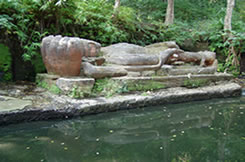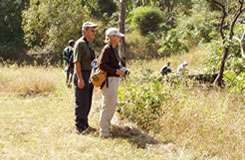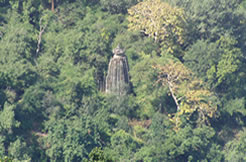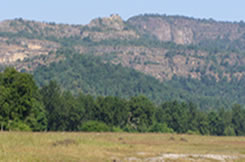The Tiger's power has made it nature's most efficient predator. The tiger is closely linked with its habitat, its co- predators and of course its prey. All the members of this closely linked system live in harmony with one another in two of our most famous national parks -Kanha and Bandhavgarh.
Bandhavgarh National Park
Set among the Vindhya Hills in the state of Madhya Pradesh, Bandhavgarh consists of 168 square miles of Sal trees and mixed forest with large stretches of bamboo and grassland to the north. There is a fascinating fort at the parks center, 1,000 feet above the surrounding countryside. The Bandhavgarh Fort, in the center of the Reserve, atop the Bandhavgarh hill, was the seat of the rulers of Rewa State until they shifted to Rewa town in 1617 A.D. The area of the Reserve, with its surrounding forests, was the favorite hunting ground of the erstwhile rulers. The adjoining Panpatha sanctuary, which was created in 1993 with an area of 245.847sq.km, was also declared a part of the Reserve. In addition to tigers, you can hope to see chital, sambar deer, chinkara (Indian antelope), grey langur, rhesus macaque, and wild boar. There are some 250 species of birds here including the blue-bearded bee-eaters and white-browed fantails, and the Malabar hornbill. Wildlife viewing is by open jeep and elephant back. Boarding elephants is easy, and the cushioned platforms are very comfortable. Since most animals, including tigers, have little fear of (but respect for) elephants or the people mounted on them, this mode of transportation is ideal for wildlife viewing. There are morning and afternoon wildlife excursions and we have the option to visit the fort. A 35-feet statue of the reclining Vishnu, resting beside a rectangular pool of spring water, heads the path to the imposing main gate. In addition to 10th Century rock images of the incarnation of Vishnu, Bandhavgarh Fort offers breathtaking views and excellent game viewing.
Kanha National Park
Kanha National Park , also called 'Tiger Country', located in the Mandla district of Madhya Pradesh covering about 1940 sq km. This jungle inspired Kipling's Jungle Book. The park was created in 1955 by a special law and, since then, it has been dedicated to pReserveing wildlife, saving many endangered species in the process. In 1974, it got the status of a TIGER ReserveE under the Project Tiger Scheme. This National Park has thick vegetation of Sal and Bamboo forests, grasslands and streams. Kanha National Park is main habitat of barasingha (swamp deer) in India. Swamp deer are surviving here on account of the tall grass field based in this park. Besides this, as many as 260 birds' species - eagle, hawks, vulture, wheat-eater are reported in this park. Kanha national park boasts of about 30 mammalian species. The gaur, the largest of the world's cattle; the sambhar, the largest Indian deer; and the four horned antelope, Besides the tigers, you can also observe a porcupine, gray langurs, mongoose, hyena, jungle cat, leopard, wild dog and wild hog,
Save the Tiger
The tiger is the spirit of these Jungles and on top of the food chain. A healthy tiger population signifies a healthy jungle. It is our mission to educate people & make them concerned about conservation of wildlife and also provide people with closes glimpses of these magnificent living beings in order to create empathy for all endangered species.
"SAVE TIGER" tours provide a memorable and cost effective insight into local community life whilst also generating direct benefits to these communities and helping them to protect their cultural and natural heritage for future generations.
The local inhabitants who have settled in the vicinity of the national parks and Reserves suffer losses of livestock and destruction of agricultural produce due to wild herbivores and predators. Hence your visit to local villages & markets and spending a few rupees there is a good way to compensate for the loss; your small contribution helps the locals generate an additional income. Through our participation with them we help to create sustainable economic alternatives to prevent them from trespassing into the parks and taking retaliatory action against the jungle invaders for the killing of their livestock.
As God is the ultimate designer of this planet then we as wise guardian ought to be attentive in pReserveing the Almighty's creation.
We are also keen to improving our relationship with all conservation organizations/teams & look forward to their assisting us in our wildlife conservation mission.
Please e-mail your suggestions to tiger@tigerexpeditions.com, along with your following information:-
Name of wildlife conservation organization/team
Postal Address
Telephone number
Your email ID
Your suggestion/s on protecting the Indian Tigers



